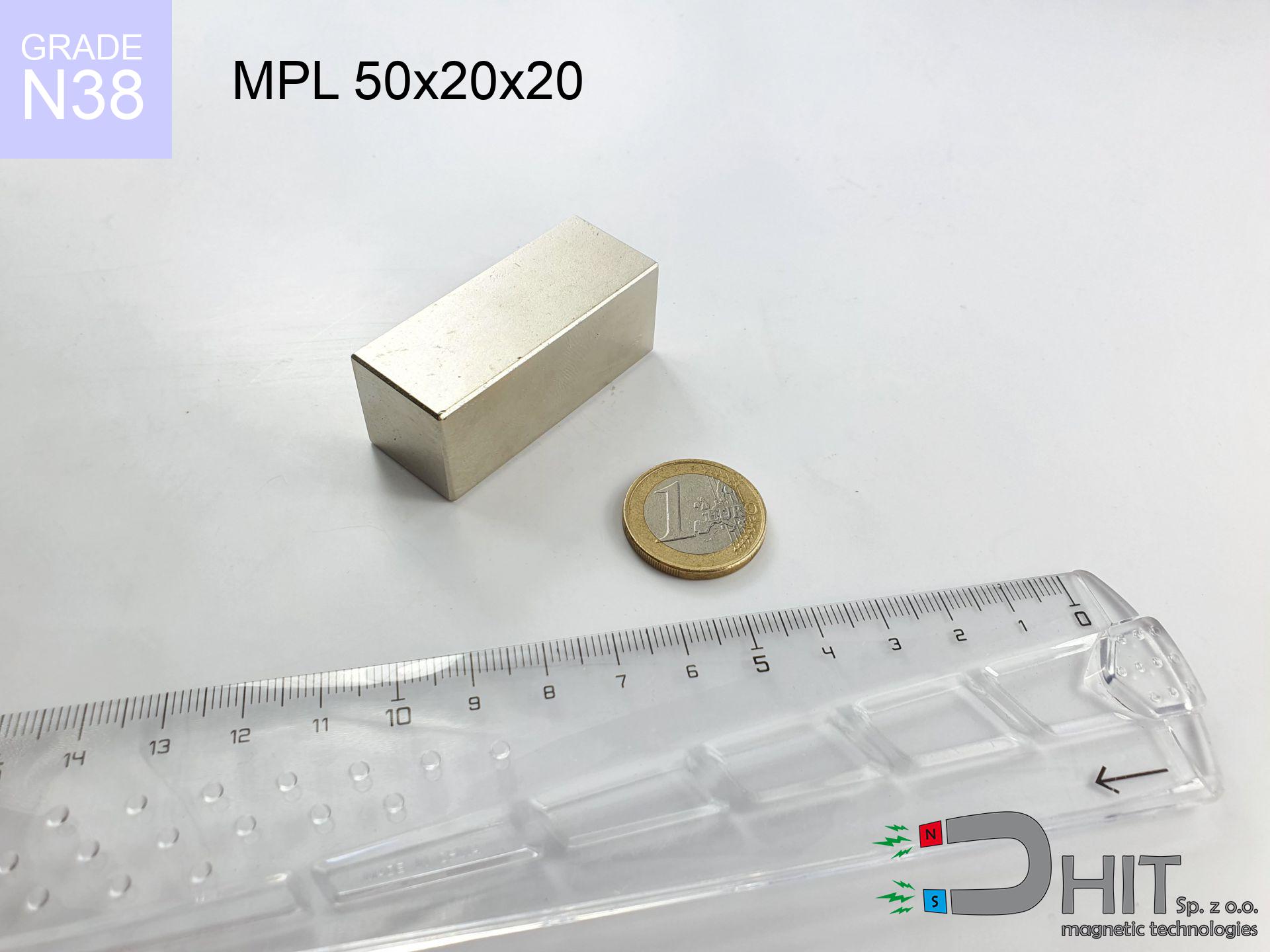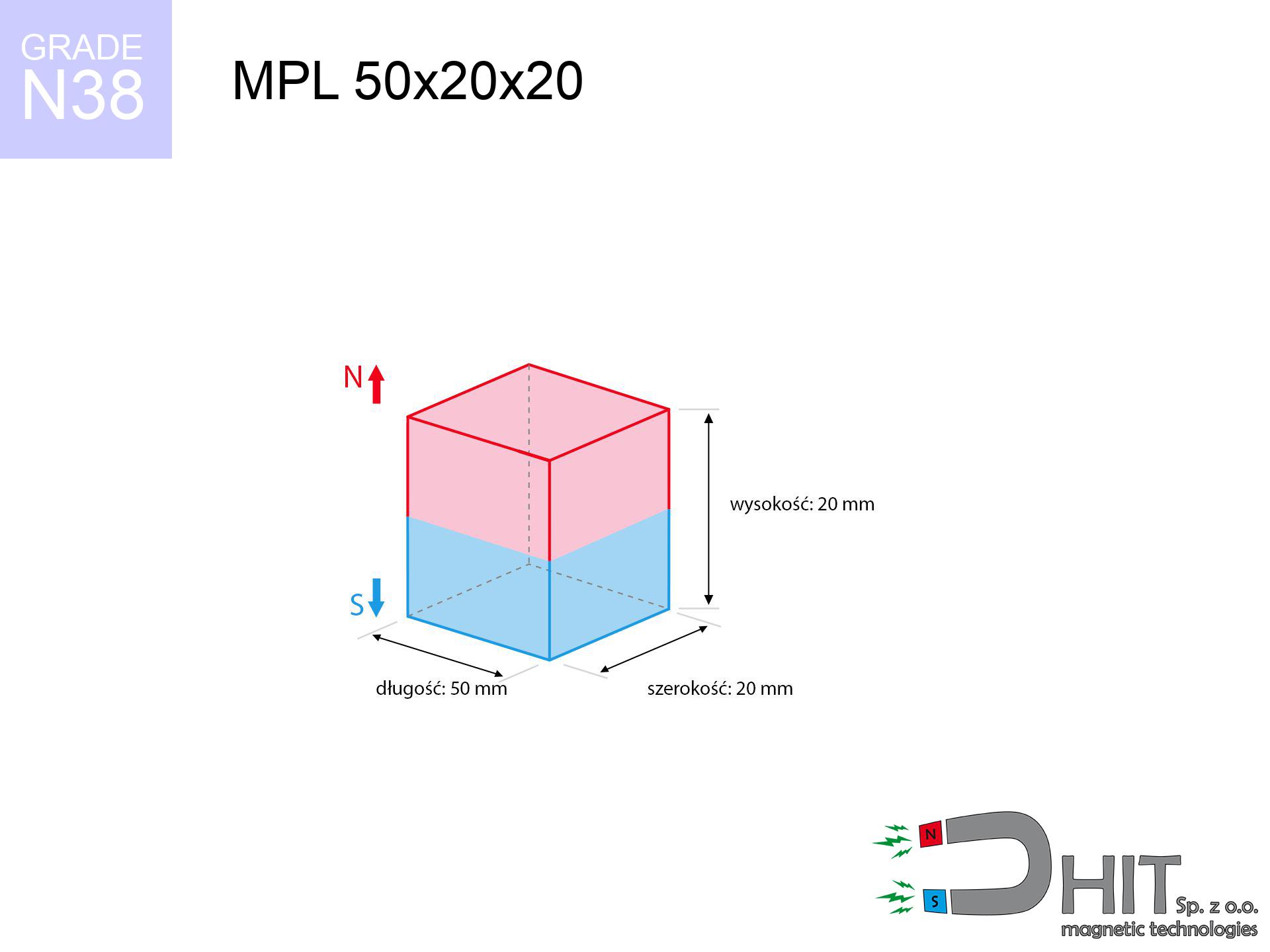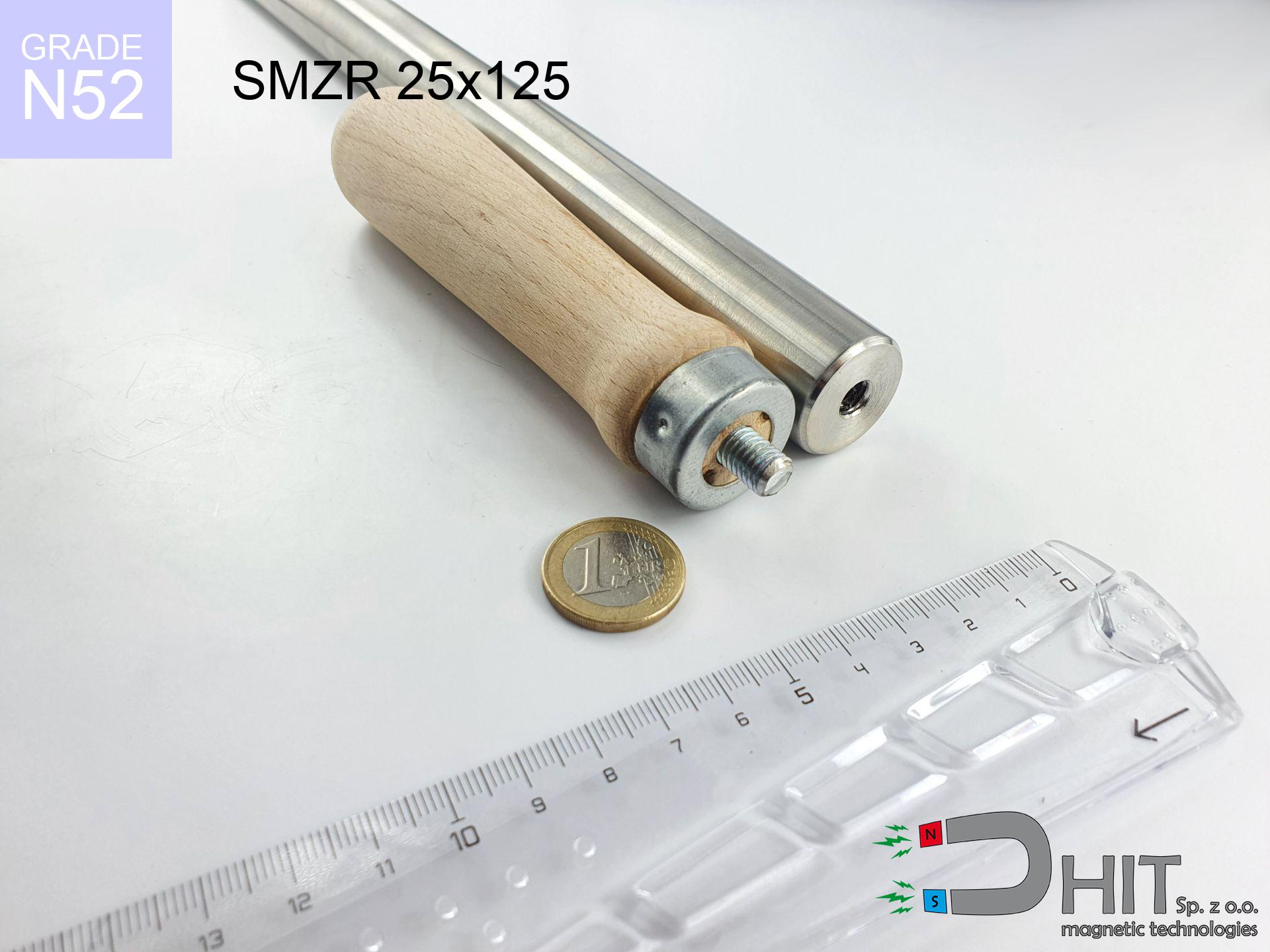MPL 50x20x20 / N38 - lamellar magnet
lamellar magnet
Catalog no 020166
GTIN/EAN: 5906301811725
length
50 mm [±0,1 mm]
Width
20 mm [±0,1 mm]
Height
20 mm [±0,1 mm]
Weight
150 g
Magnetization Direction
↑ axial
Load capacity
42.18 kg / 413.81 N
Magnetic Induction
478.99 mT / 4790 Gs
Coating
[NiCuNi] Nickel
47.32 ZŁ with VAT / pcs + price for transport
38.47 ZŁ net + 23% VAT / pcs
bulk discounts:
Need more?Want to negotiate?
Call us now
+48 22 499 98 98
or get in touch using
form
through our site.
Parameters as well as form of a neodymium magnet can be analyzed on our
magnetic mass calculator.
Same-day processing for orders placed before 14:00.
MPL 50x20x20 / N38 - lamellar magnet
Specification / characteristics MPL 50x20x20 / N38 - lamellar magnet
| properties | values |
|---|---|
| Cat. no. | 020166 |
| GTIN/EAN | 5906301811725 |
| Production/Distribution | Dhit sp. z o.o. |
| Country of origin | Poland / China / Germany |
| Customs code | 85059029 |
| length | 50 mm [±0,1 mm] |
| Width | 20 mm [±0,1 mm] |
| Height | 20 mm [±0,1 mm] |
| Weight | 150 g |
| Magnetization Direction | ↑ axial |
| Load capacity ~ ? | 42.18 kg / 413.81 N |
| Magnetic Induction ~ ? | 478.99 mT / 4790 Gs |
| Coating | [NiCuNi] Nickel |
| Manufacturing Tolerance | ±0.1 mm |
Magnetic properties of material N38
| properties | values | units |
|---|---|---|
| remenance Br [min. - max.] ? | 12.2-12.6 | kGs |
| remenance Br [min. - max.] ? | 1220-1260 | mT |
| coercivity bHc ? | 10.8-11.5 | kOe |
| coercivity bHc ? | 860-915 | kA/m |
| actual internal force iHc | ≥ 12 | kOe |
| actual internal force iHc | ≥ 955 | kA/m |
| energy density [min. - max.] ? | 36-38 | BH max MGOe |
| energy density [min. - max.] ? | 287-303 | BH max KJ/m |
| max. temperature ? | ≤ 80 | °C |
Physical properties of sintered neodymium magnets Nd2Fe14B at 20°C
| properties | values | units |
|---|---|---|
| Vickers hardness | ≥550 | Hv |
| Density | ≥7.4 | g/cm3 |
| Curie Temperature TC | 312 - 380 | °C |
| Curie Temperature TF | 593 - 716 | °F |
| Specific resistance | 150 | μΩ⋅cm |
| Bending strength | 250 | MPa |
| Compressive strength | 1000~1100 | MPa |
| Thermal expansion parallel (∥) to orientation (M) | (3-4) x 10-6 | °C-1 |
| Thermal expansion perpendicular (⊥) to orientation (M) | -(1-3) x 10-6 | °C-1 |
| Young's modulus | 1.7 x 104 | kg/mm² |
Technical modeling of the magnet - technical parameters
Presented values represent the result of a physical simulation. Values rely on algorithms for the material Nd2Fe14B. Real-world performance may differ from theoretical values. Treat these calculations as a preliminary roadmap when designing systems.
MPL 50x20x20 / N38
| Distance (mm) | Induction (Gauss) / mT | Pull Force (kg) | Risk Status |
|---|---|---|---|
| 0 mm |
4789 Gs
478.9 mT
|
42.18 kg / 42180.0 g
413.8 N
|
dangerous! |
| 1 mm |
4452 Gs
445.2 mT
|
36.46 kg / 36461.5 g
357.7 N
|
dangerous! |
| 2 mm |
4114 Gs
411.4 mT
|
31.13 kg / 31126.5 g
305.4 N
|
dangerous! |
| 3 mm |
3784 Gs
378.4 mT
|
26.34 kg / 26336.3 g
258.4 N
|
dangerous! |
| 5 mm |
3173 Gs
317.3 mT
|
18.52 kg / 18523.4 g
181.7 N
|
dangerous! |
| 10 mm |
2022 Gs
202.2 mT
|
7.52 kg / 7522.9 g
73.8 N
|
strong |
| 15 mm |
1324 Gs
132.4 mT
|
3.22 kg / 3222.6 g
31.6 N
|
strong |
| 20 mm |
899 Gs
89.9 mT
|
1.49 kg / 1487.5 g
14.6 N
|
safe |
| 30 mm |
458 Gs
45.8 mT
|
0.39 kg / 385.8 g
3.8 N
|
safe |
| 50 mm |
159 Gs
15.9 mT
|
0.05 kg / 46.4 g
0.5 N
|
safe |
MPL 50x20x20 / N38
| Distance (mm) | Friction coefficient | Pull Force (kg) |
|---|---|---|
| 0 mm | Stal (~0.2) |
8.44 kg / 8436.0 g
82.8 N
|
| 1 mm | Stal (~0.2) |
7.29 kg / 7292.0 g
71.5 N
|
| 2 mm | Stal (~0.2) |
6.23 kg / 6226.0 g
61.1 N
|
| 3 mm | Stal (~0.2) |
5.27 kg / 5268.0 g
51.7 N
|
| 5 mm | Stal (~0.2) |
3.70 kg / 3704.0 g
36.3 N
|
| 10 mm | Stal (~0.2) |
1.50 kg / 1504.0 g
14.8 N
|
| 15 mm | Stal (~0.2) |
0.64 kg / 644.0 g
6.3 N
|
| 20 mm | Stal (~0.2) |
0.30 kg / 298.0 g
2.9 N
|
| 30 mm | Stal (~0.2) |
0.08 kg / 78.0 g
0.8 N
|
| 50 mm | Stal (~0.2) |
0.01 kg / 10.0 g
0.1 N
|
MPL 50x20x20 / N38
| Surface type | Friction coefficient / % Mocy | Max load (kg) |
|---|---|---|
| Raw steel |
µ = 0.3
30% Nominalnej Siły
|
12.65 kg / 12654.0 g
124.1 N
|
| Painted steel (standard) |
µ = 0.2
20% Nominalnej Siły
|
8.44 kg / 8436.0 g
82.8 N
|
| Oily/slippery steel |
µ = 0.1
10% Nominalnej Siły
|
4.22 kg / 4218.0 g
41.4 N
|
| Magnet with anti-slip rubber |
µ = 0.5
50% Nominalnej Siły
|
21.09 kg / 21090.0 g
206.9 N
|
MPL 50x20x20 / N38
| Steel thickness (mm) | % power | Real pull force (kg) |
|---|---|---|
| 0.5 mm |
|
2.11 kg / 2109.0 g
20.7 N
|
| 1 mm |
|
5.27 kg / 5272.5 g
51.7 N
|
| 2 mm |
|
10.55 kg / 10545.0 g
103.4 N
|
| 5 mm |
|
26.36 kg / 26362.5 g
258.6 N
|
| 10 mm |
|
42.18 kg / 42180.0 g
413.8 N
|
MPL 50x20x20 / N38
| Ambient temp. (°C) | Power loss | Remaining pull | Status |
|---|---|---|---|
| 20 °C | 0.0% |
42.18 kg / 42180.0 g
413.8 N
|
OK |
| 40 °C | -2.2% |
41.25 kg / 41252.0 g
404.7 N
|
OK |
| 60 °C | -4.4% |
40.32 kg / 40324.1 g
395.6 N
|
OK |
| 80 °C | -6.6% |
39.40 kg / 39396.1 g
386.5 N
|
|
| 100 °C | -28.8% |
30.03 kg / 30032.2 g
294.6 N
|
MPL 50x20x20 / N38
| Gap (mm) | Attraction (kg) (N-S) | Repulsion (kg) (N-N) |
|---|---|---|
| 0 mm |
141.37 kg / 141367 g
1386.8 N
5 687 Gs
|
N/A |
| 1 mm |
131.73 kg / 131727 g
1292.2 N
9 245 Gs
|
118.55 kg / 118555 g
1163.0 N
~0 Gs
|
| 2 mm |
122.20 kg / 122202 g
1198.8 N
8 904 Gs
|
109.98 kg / 109981 g
1078.9 N
~0 Gs
|
| 3 mm |
113.05 kg / 113050 g
1109.0 N
8 564 Gs
|
101.74 kg / 101745 g
998.1 N
~0 Gs
|
| 5 mm |
96.05 kg / 96052 g
942.3 N
7 894 Gs
|
86.45 kg / 86447 g
848.0 N
~0 Gs
|
| 10 mm |
62.08 kg / 62082 g
609.0 N
6 347 Gs
|
55.87 kg / 55873 g
548.1 N
~0 Gs
|
| 20 mm |
25.21 kg / 25213 g
247.3 N
4 045 Gs
|
22.69 kg / 22692 g
222.6 N
~0 Gs
|
| 50 mm |
2.46 kg / 2464 g
24.2 N
1 264 Gs
|
2.22 kg / 2218 g
21.8 N
~0 Gs
|
MPL 50x20x20 / N38
| Object / Device | Limit (Gauss) / mT | Safe distance |
|---|---|---|
| Pacemaker | 5 Gs (0.5 mT) | 19.0 cm |
| Hearing aid | 10 Gs (1.0 mT) | 15.0 cm |
| Mechanical watch | 20 Gs (2.0 mT) | 11.5 cm |
| Phone / Smartphone | 40 Gs (4.0 mT) | 9.0 cm |
| Remote | 50 Gs (5.0 mT) | 8.5 cm |
| Payment card | 400 Gs (40.0 mT) | 3.5 cm |
| HDD hard drive | 600 Gs (60.0 mT) | 3.0 cm |
MPL 50x20x20 / N38
| Start from (mm) | Speed (km/h) | Energy (J) | Predicted outcome |
|---|---|---|---|
| 10 mm |
18.70 km/h
(5.20 m/s)
|
2.02 J | |
| 30 mm |
29.46 km/h
(8.18 m/s)
|
5.02 J | |
| 50 mm |
37.84 km/h
(10.51 m/s)
|
8.29 J | |
| 100 mm |
53.48 km/h
(14.86 m/s)
|
16.55 J |
MPL 50x20x20 / N38
| Technical parameter | Value / Description |
|---|---|
| Coating type | [NiCuNi] Nickel |
| Layer structure | Nickel - Copper - Nickel |
| Layer thickness | 10-20 µm |
| Salt spray test (SST) ? | 24 h |
| Recommended environment | Indoors only (dry) |
MPL 50x20x20 / N38
| Parameter | Value | SI Unit / Description |
|---|---|---|
| Magnetic Flux | 46 654 Mx | 466.5 µWb |
| Pc Coefficient | 0.63 | High (Stable) |
MPL 50x20x20 / N38
| Environment | Effective steel pull | Effect |
|---|---|---|
| Air (land) | 42.18 kg | Standard |
| Water (riverbed) |
48.30 kg
(+6.12 kg Buoyancy gain)
|
+14.5% |
1. Vertical hold
*Note: On a vertical surface, the magnet retains only a fraction of its nominal pull.
2. Efficiency vs thickness
*Thin metal sheet (e.g. computer case) drastically limits the holding force.
3. Power loss vs temp
*For standard magnets, the max working temp is 80°C.
4. Demagnetization curve and operating point (B-H)
chart generated for the permeance coefficient Pc (Permeance Coefficient) = 0.63
The chart above illustrates the magnetic characteristics of the material within the second quadrant of the hysteresis loop. The solid red line represents the demagnetization curve (material potential), while the dashed blue line is the load line based on the magnet's geometry. The Pc (Permeance Coefficient), also known as the load line slope, is a dimensionless value that describes the relationship between the magnet's shape and its magnetic stability. The intersection of these two lines (the black dot) is the operating point — it determines the actual magnetic flux density generated by the magnet in this specific configuration. A higher Pc value means the magnet is more 'slender' (tall relative to its area), resulting in a higher operating point and better resistance to irreversible demagnetization caused by external fields or temperature. A value of 0.42 is relatively low (typical for flat magnets), meaning the operating point is closer to the 'knee' of the curve — caution is advised when operating at temperatures near the maximum limit to avoid strength loss.
Elemental analysis
| iron (Fe) | 64% – 68% |
| neodymium (Nd) | 29% – 32% |
| boron (B) | 1.1% – 1.2% |
| dysprosium (Dy) | 0.5% – 2.0% |
| coating (Ni-Cu-Ni) | < 0.05% |
Ecology and recycling (GPSR)
| recyclability (EoL) | 100% |
| recycled raw materials | ~10% (pre-cons) |
| carbon footprint | low / zredukowany |
| waste code (EWC) | 16 02 16 |
Other deals
Pros as well as cons of Nd2Fe14B magnets.
Benefits
- They retain attractive force for nearly 10 years – the loss is just ~1% (in theory),
- They are resistant to demagnetization induced by presence of other magnetic fields,
- The use of an metallic layer of noble metals (nickel, gold, silver) causes the element to have aesthetics,
- Magnets are characterized by extremely high magnetic induction on the working surface,
- Made from properly selected components, these magnets show impressive resistance to high heat, enabling them to function (depending on their form) at temperatures up to 230°C and above...
- Possibility of exact forming and optimizing to individual applications,
- Universal use in high-tech industry – they find application in magnetic memories, drive modules, medical equipment, and other advanced devices.
- Relatively small size with high pulling force – neodymium magnets offer impressive pulling force in small dimensions, which enables their usage in miniature devices
Disadvantages
- Brittleness is one of their disadvantages. Upon strong impact they can break. We recommend keeping them in a special holder, which not only protects them against impacts but also increases their durability
- We warn that neodymium magnets can reduce their power at high temperatures. To prevent this, we advise our specialized [AH] magnets, which work effectively even at 230°C.
- Magnets exposed to a humid environment can rust. Therefore while using outdoors, we recommend using water-impermeable magnets made of rubber, plastic or other material protecting against moisture
- Limited ability of producing threads in the magnet and complicated forms - preferred is cover - magnet mounting.
- Possible danger resulting from small fragments of magnets can be dangerous, if swallowed, which is particularly important in the aspect of protecting the youngest. It is also worth noting that tiny parts of these products can complicate diagnosis medical in case of swallowing.
- Due to expensive raw materials, their price is relatively high,
Pull force analysis
Optimal lifting capacity of a neodymium magnet – what affects it?
- with the application of a yoke made of special test steel, ensuring full magnetic saturation
- with a cross-section minimum 10 mm
- with an ideally smooth touching surface
- with zero gap (without impurities)
- during pulling in a direction perpendicular to the plane
- in stable room temperature
Key elements affecting lifting force
- Space between surfaces – every millimeter of distance (caused e.g. by veneer or dirt) diminishes the pulling force, often by half at just 0.5 mm.
- Loading method – declared lifting capacity refers to detachment vertically. When attempting to slide, the magnet exhibits much less (often approx. 20-30% of nominal force).
- Plate thickness – insufficiently thick steel does not accept the full field, causing part of the power to be wasted to the other side.
- Plate material – low-carbon steel attracts best. Alloy steels decrease magnetic properties and holding force.
- Surface condition – ground elements ensure maximum contact, which improves field saturation. Uneven metal weaken the grip.
- Thermal conditions – neodymium magnets have a sensitivity to temperature. When it is hot they are weaker, and at low temperatures they can be stronger (up to a certain limit).
Lifting capacity testing was conducted on a smooth plate of suitable thickness, under a perpendicular pulling force, in contrast under attempts to slide the magnet the holding force is lower. In addition, even a small distance between the magnet and the plate reduces the holding force.
Keep away from computers
Very strong magnetic fields can destroy records on credit cards, HDDs, and storage devices. Maintain a gap of min. 10 cm.
No play value
These products are not toys. Eating several magnets may result in them connecting inside the digestive tract, which poses a critical condition and requires urgent medical intervention.
Dust explosion hazard
Combustion risk: Rare earth powder is highly flammable. Do not process magnets in home conditions as this may cause fire.
Impact on smartphones
A powerful magnetic field interferes with the functioning of compasses in smartphones and navigation systems. Maintain magnets close to a device to prevent damaging the sensors.
Implant safety
Warning for patients: Strong magnetic fields disrupt medical devices. Maintain at least 30 cm distance or ask another person to handle the magnets.
Permanent damage
Standard neodymium magnets (grade N) lose magnetization when the temperature exceeds 80°C. This process is irreversible.
Sensitization to coating
Medical facts indicate that the nickel plating (standard magnet coating) is a strong allergen. If your skin reacts to metals, refrain from direct skin contact or select coated magnets.
Pinching danger
Pinching hazard: The attraction force is so great that it can cause hematomas, crushing, and broken bones. Use thick gloves.
Handling guide
Be careful. Neodymium magnets act from a long distance and connect with huge force, often faster than you can move away.
Beware of splinters
Neodymium magnets are sintered ceramics, meaning they are very brittle. Clashing of two magnets leads to them cracking into shards.









